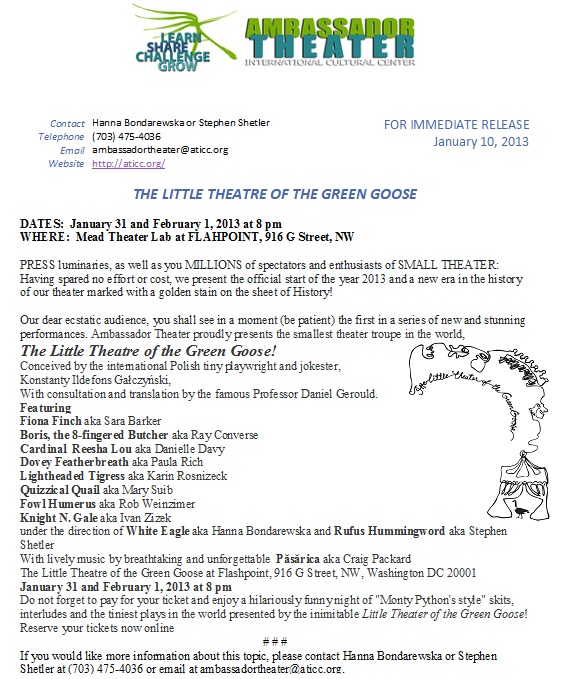JANUARY 17, 2013Â BYÂ LORRAINE TREANOR
We admit it – when Artistic Director Hanna Bondarewska sent the Ambassador Theater’s press release for their upcoming performances at Flashpoint Gallery, our email back could be capsulized as “huh?â€
See for yourselves how the clever Bondarewska had us begging to know more:
“Having spared no effort or cost, we present the official start of the year 2013 and a new era in the history of our theater marked with a golden stain on the sheet of History! Our dear ecstatic audience, you shall see in a moment (be patient) the first in a series of new and stunning performances. Ambassador Theater proudly presents the smallest theater troupe in the world, The Little Theatre of the Green Goose!â€
Enter Ray Converse, a member of the Green Goose ensemble, to explain:
Ray Converse: “These plays were written in the late 1940s by Konstanty Ildefons Galczynski , a much beloved Polish poet and humorist who is virtually unknown in the U.S.  Galczynski wrote these plays after spending all of World War II as a POW in a German camp [mainly at Stalag XI-A].
“The plays are vignettes that point the audience to the absurdities of life.  Written in the early years after the war, the plays were never performed during his lifetime for two reasons: first, he deliberately wrote the plays so they could not be staged, and second, with the onset of Stalinism in Poland, these plays were found incompatible with government-approved Socialist Realism.
“The first Green Goose performance of any kind was in the Grotesque Puppet Theatre in Cracow in 1955.
“The original intent was to do Green Goose as a staged reading.  After all the author originally did not intend them to be performed.â€
DCTS: and yet, you are performing them …
Ray: “It quickly became clear that a staged-reading would not do justice to Galczynski’s work.  There is too much physicality in these plays for the audience to enjoy them with the artists with scripts in hand.  As a result, the original premise changed to doing a bare-bones production.  Even then, it soon it became apparent that the material needed to become more, a bare-bones production on steroids.â€
DCTS: What will the evening be like for the audience?
“The separate plays are strung together with the premise that the actors are part of
a scruffy, semi-inept medieval acting troupe journeying across the country.   (It might be compared to a medieval flash mob.)â€
DCTS: Hmm… interesting image.
Ray: “Each of the players has a distinct character and name which they bring to the role when they are not in their stage roles.  At curtain, the players arrive in town during a downpour as a Salvation Army Band led by a pamphlet-selling evangelist, perform their individual plays, pass the hat, and flee the town before the local constabulary can arrest them.
“The humor is slapstick on one level, but also operates on a higher level.â€
DCTS: For those who like to know what the plays are about …
Ray: “Two common threads appear in many of these plays.  They play with the idea of what happens if some unplanned random event messes up the universal plan?  Without divulging any secrets, the apple in the Garden of Eden could be too tasty to share?
And, the plays explore the consequences of people feeling too strongly – boredom, loneliness, love.  Devotees of Starbucks coffee will find themselves as the leading character in one of these and will be laughing about it as they exit the theater, looking for a nearby Starbucks. ..to read more





